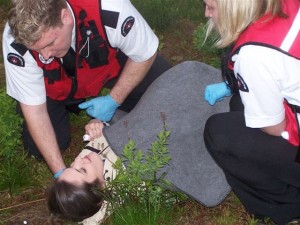Participants enrolled in emergency first aid will learn about cardiovascular diseases and emergencies that relate to and include heart attacks. Cardiovascular disease is the number one killer of North Americans over the age of 44. Emergency first aid teaches candidates how to recognize and provide care for patients suffering from heart attacks. This page will outline the signs and symptoms and the ideal care for a patient showing signs of a heart attack. The material posted on this page is for information purposes only. To learn to recognize and treat a heart attack patient take an emergency first aid course in Saskatoon. Other training partner locations include Vancouver, Ottawa, Edmonton, Calgary, Kelowna, Surrey, Regina, and Winnipeg.
Signs and Symptoms of Heart Attacks.
Patients with Heart Attacks can show one, a combination of, or none of the following signs and symptoms:
- Shortness of Breath.
- Tightness in the chest area (chest can feel heavy).
- Difficulty Breathing.
- Numbness in one arm or both.
- Pain radiating outwards from the chest which might include the jaw and stomach pain.
Additional Notes:
A heart attack may have been triggered by increased amounts of physical activity or mental or physical anxiety. Rescuers should attempt to determine the history of the patient. Patients should be asked if they have any previous or current heart conditions or medical history that would be related to this event.
Providing Care for patients with suspected Heart Attacks.
Participants or rescuers providing care for a patient should monitor or provide the following:
- Monitor vitals including patient’s airway, breathing, and circulation. Rescuers (s) are encouraged to record patients’ vitals if possible.
- The patient should maintain an open airway.
- Contact emergency medical services (EMS).
If unsure you should always treat the victim for shock - Place patient into a position of comfort. Semi-sitting positions should be encouraged.
- Rescuers should notify a bystander to contact EMS and retrieve an automated external defibrillator (AED).
- Rescuers should encourage patients to take any medication that the patient may have related to the condition. Rescuers should not administer the medication but can help make sure the medication is the proper amount, not expired, and is prescribed to the patient. Common medications for patients susceptible to heart conditions include nitroglycerin (nitro) or acetylsalicylic acid (Aspirin). Patients should be advised not to substitute medications such as Aspirin for another medication such as Tylenol. Patients prescribed nitroglycerin should be advised not to take the medication if they are on any performance-enhancing medications such as Viagra or Cialis.
- Patients should be encouraged to reduce movement and relax.
- The rescuer should treat the patient for shock.
- If vitals are absent rescuer(s) should administer CPR and use an AED and follow prompts if available.
Participants registered in emergency first aid will learn to provide care using all of the techniques mentioned above. Candidates must demonstrate effective skills in the care of heart attack patients to successfully complete an emergency first aid course.
